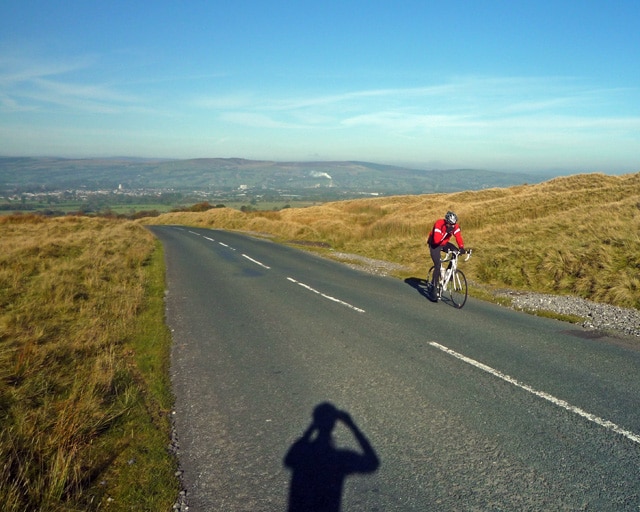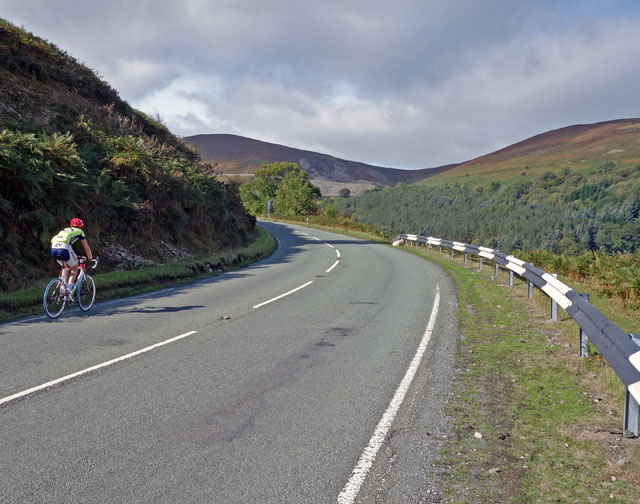Whether you are an outdoor cyclist a Spinner or both, why and how do you want to climb your hills? What are the benefits and WHY do they make us stronger? I LOVE hill climbing and it is truly my passion on the outdoor bike and the indoor bike as well. In researching the topic of climbing using interval training, this is what I found. I read a lot of articles and coupled them with my own experience. The best site that I found was: www.cyclinguphill.com
Warming Up/ Early Hill Climb sessions
During the early part of the hill climb season, I’m getting used to riding at or above race pace. A typical session might involve:
- Warm up for 15 minutes
- 3 * 1 minute intervals at 95% – this is about 400 watts. They are not completely ‘eyeballs out’ I like to break myself in a bit more gently.
- 7 * 4 – 5 minutes. To make it more interesting, I do intervals up real hills. The hill climb may last between 3 and a half minutes and 5 minutes, depending on where I’m training. I do the first one really hard, but not 100% as if I was doing a hill climb.
I’m most interested in maintaining high power towards the end of interval and towards the end of the interval session. A good indicator of form is how I go during the 6th or 7th interval. In that sense the intervals get harder as you progress towards the end because the muscles are tired and you are carrying around more lactic acid.
If my FTP is 290, I might be doing these intervals at 350 watts. – Or 20% harder than an effort during an hour’s constant time trial.
In between these intervals I ride at a recovery pace. Gently spinning to try and get rid of the lactic acid.
In a typical interval session, it might take 2 and half hours and take 50 miles.
At this time of the year, I might just do one a week. In peak hill climb training season, perhaps two. Generally, I need an easy day before and after to get the most from them. To be honest, if I really do a proper hill climb interval session, you don’t feel like doing anything other than a recovery ride the next day.
After the interval session, I recommend some stretching especially of hamstrings.
Aim of hill climb intervals
- Increase climbing ability
- By racing above your normal race pace, you hope to stress the muscles and heart to pull up your capacity. The main aim for time trialling is to increase your Functional Threshold power (FTP) – roughly the effort / power you can maintain for an effort of an hour. Intervals can do this
- One way to train for an hour time trial is to train for an hour and see how fast you can do it. Intervals are deliberately training for a shorter time so you can ride at a level higher than what you can maintain for a long time.
- Train different muscle fibres. In road races and even short distance time trials (25 miles), you will be using all three muscle fibres – slow twitch, fast twitch and super-fast twitch. Hill climb intervals are a way to train all three. You don’t get this training effect, just by riding hard for an hour.
- Get used to dealing with lactic acid.
- My main early season target is several hilly time trials. These interval sessions replicate hilly time trials quite well. The only difference is that I’m not racing in between hills – only when going up the hills.
Riding the hill climb intervals

Now I have a power meter I do spend a bit of time looking at the power meter to try and gauge effort and smooth over the effort during a climb. This generally involves, holding back a little at the bottom, but then making an even bigger effort towards the end of the interval to maintain the power. I think a power meter is useful in the sense it shows what you are actually putting out. I didn’t realise how easy it is for power to peter out, when the slope eases off at the top.
On the downside having a power meter slightly detracts from the ‘purity’ of just riding as hard as you can. It is possible, I might have felt better about an interval, if the power meter hadn’t been telling me that my power was lower than I would like.
But, then sometimes during interval session, you get tired of looking at power meter and you just concentrate on riding the hill. There’s a lot to be said for just riding on feel and they looking at data after the ride.
Hill climb intervals are by definition painful. That’s part of the challenge / enjoyment. Maybe it’s in a hill climbers DNA, but I have to admit I kind of really look forward to the effort of doing them. There is something that really enjoys riding on the edge for four to five minutes. I guess you have to have a similar attraction to intervals otherwise it would be very hard to do them.
Though yesterday, I was just full of lactic acid for the whole session and a couple of hours after, that wasn’t particularly nice.
When to stop intervals

- A good question is when do you stop doing your intervals? Do you ride a set number whatever? Or do you stop when you feel you’ve done enough?
- From a personal perspective, I only start off with a rough idea of how many I will do. Whilst I can do a good quality interval I generally keep going. But, there usually comes a point, when I know my legs are gone, and I couldn’t ride for 5 minutes at above FTP. I will definitely stop. There’s no point beating a dead horse so to speak. It’s also worth bearing in mind, it’s not all about this one interval session. If you really beat yourself up doing a 100 intervals, you will compromise future training sessions. It’s better to leave just a little bit, concentrate on recovery and then you will be able to train again sooner. I’ve also been carrying a few hangovers from my Jan accident, like a marginally tight hamstring so this is another reason not to overdo it.
- The number of intervals is very individual. In my first seasons training, all I could manage was about three intervals, then I was completely popped. After years of riding and training, that number has steadily gone up. Last year I did some pyramid intervals which would simply have been impossible without considerable endurance and base training, built up over several years. It also varies depending on the time of the year. The first hill climb interval of the year, is generally a short affair, just a couple to get back into it.
To give one example, my first hill climb interval in Feb, my 7th interval 5 min interval was at 293 watts. In March my 7th interval was at 335 watts. The biggest gain in performance was for my last interval.
Pyramid intervals
When the season heats up and I really want to peak, I will add more shorter hill climb intervals before the longer 5 minutes.
- Several sprint intervals of 15 seconds – high cadence – 100% all out.
- after a suitable period of recovery, I will move onto 1 minute intervals. Again high cadence – 100% all out. Upto nine of these.
- The third session is to move onto the five minute intervals.
As you can imagine this is a really hard interval session and requires considerable motivation. Because it’s early season, I’m not jumping in with a full pyramid interval session. However, I try to do the odd sprint interval throughout the year, just to prevent those fast muscle fibres fading. Use it or lose it is what they say as you get older.
Personal preferences for hill climb intervals
Personally, I really enjoy racing up hills. I prefer the session without the sprint intervals to start with. This is because you arrive at the proper ‘five minute’ hills already tired and you can’t really race. But, if you want to train all three muscle fibres, I’m sure the pyramid intervals work.
I also enjoy recording my times up different hills, it gives a sense of where you are at, and what kind of progress you are making. It is especially good in the early season, where you can easily knock off time from your seasons best. But, if you’re tired from sprint intervals, you can’t beat your own times.

No comments:
Post a Comment
Please feel free to leave any questions or comments!